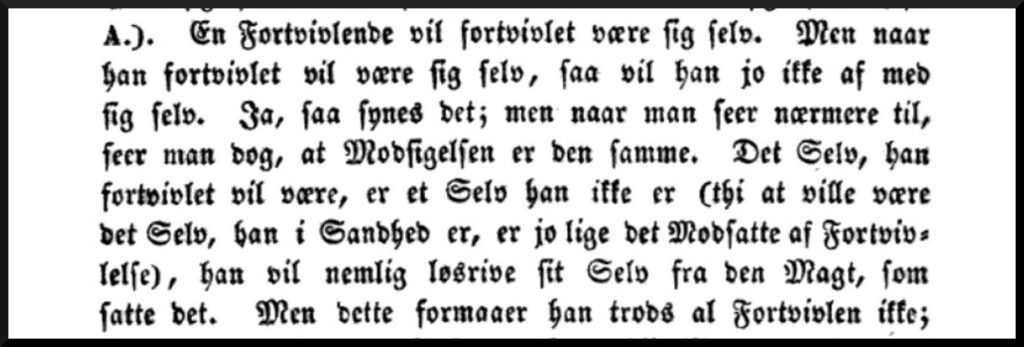Søren Kierkegaard? Carl Rogers? John Rowan? Howard Sasportas? Walter Lowrie? Anonymous?

Question for Quote Investigator: Unhappy people often feel compelled to wear a social mask and to live inauthentic lives. Danish theologian and existentialist philosopher Søren Kierkegaard has been credited with the following remark:
The most common form of despair is not being who you are.
I have been unable to find a citation and have become skeptical of this attribution. Would you please explore the provenance of this statement?
Reply from Quote Investigator: QI believes that this statement evolved over time from passages written by Søren Kierkegaard in his 1849 book “Sygdommen til Døden” (“The Sickness unto Death”). An English translation by Walter Lowrie was published in 1941. Kierkegaard discussed despair extensively in the book. The following sentences contained the central idea of the quotation although the expression was somewhat convoluted. Boldface added to excerpt s by QI:1
A despairing man wants despairingly to be himself. But if he despairingly wants to be himself, he will not want to get rid of himself. Yes, so it seems; but if one inspects more closely, one perceives that after all the contradiction is the same. That self which he despairingly wills to be is a self which he is not (for to will to be that self which one truly is, is indeed the opposite of despair); what he really wills is to tear his self away from the Power which constituted it.
The central idea was also expressed in the following passage:2
This form of despair is: in despair at not willing to be oneself; or still lower, in despair at not willing to be a self; or lowest of all, in despair at willing to be another than himself.
In 1956 the influential U.S. psychologist Carl Rogers published an article in the journal “Pastoral Psychology”. Rogers wrote a paraphrase of the viewpoint expressed by Søren Kierkegaard:3
In this connection I have been astonished to find how accurately the Danish philosopher, Soren Kierkegaard, pictured the dilemma of the individual more than a century ago, with keen psychological insight. He points out that the most common despair is to be in despair at not choosing, or willing, to be one’s self; but that the deepest form of despair is to choose “to be another than himself.” On the other hand “to will to be that self which one truly is, is indeed the opposite of despair,” and this choice is the deepest responsibility of man.
This text was further paraphrased to yield the popular modern expression as indicated further below.
In 1961 Carl Rogers published his best known book, “On Becoming a Person: A Therapist’s View of Psychotherapy”, which included the 1956 essay from “Pastoral Psychology”, hence, his comments about Kierkegaard achieved further circulation.4
In 1983 John Rowan published “The Reality Game: A Guide To Humanistic Counselling and Psychotherapy” . Rowan praised Rogers as one of the great fathers of humanistic psychology, and he reprinted the passage given above while citing “On Becoming a Person”.5
In 1985 astrologer Howard Sasportas published “The Twelve Houses: An Introduction to the Houses in Astrological Interpretation” which credited Kierkegaard with the quotation under examination although the author did not use quotation marks:6
The Danish philosopher Kierkegaard observed that the most common form of despair is that of not being who we really are, adding that an even deeper form of despair stems from choosing to be someone other than oneself.
Sasportas provided a footnote which said “Carl Rogers quoting Kierkegaard cited in Rowan, The Reality Game”. In other words, Sasportas was presenting Carl Rogers interpretation of Kierkegaard which he saw in John Rowan’s book.
The excerpt above was repeated in the book “Dynamics of the Unconscious: Seminars in Psychological Astrology” by Howard Sasportas and Liz Greene.7
In 2003 the quotation collection “The Nine Modern Day Muses (and a Bodyguard)” by Jill Badonsky contained the following item:8
The most common form of despair is not being who you are.
—Søren Kierkegaard, existential philosopher
For completeness sake, here are scans of two excerpts from the 1849 book “Sygdommen til Doden” by Søren Kierkegaard in Danish. The citation in the bibliographical notes at the end of this article includes a link to the complete digital scan of the book.9


In conclusion, Søren Kierkegaard did write about despair and identity in his 1849 treatise “Sygdommen til Døden” (“The Sickness unto Death”); however, Kierkegaard did not write the quotation. Instead, the quotation was based on a paraphrase crafted by Carl Rogers in 1956. The paraphrase was further condensed by Howard Sasportas to yield the modern quotation.
Image Notes: Illustration which represents confusion about self-identity from geralt at Pixabay. The image has been resized.
Acknowledgement: Great thanks to Quinn Que whose inquiry led QI to formulate this question and perform this exploration.
- 1941, The Sickness Unto Death by Søren Kierkegaard, Translated by Walter Lowrie, Part 1,Section 1: That Despair Is the Sickness Unto Death, Quote Page 29, Humphrey Milford: Oxford University Press, London. (Verified with scans) ↩︎
- 1941, The Sickness Unto Death by Søren Kierkegaard, Translated by Walter Lowrie, Part 1, Section 3: The Forms of This Sickness, i.e., of Despair, Quote Page 83, Humphrey Milford: Oxford University Press, London. (Verified with scans) ↩︎
- 1956 April, Pastoral Psychology, Volume 7, Number 63, Becoming a Person — Part II: What It Means to Become a Person by Carl R. Rogers (Professor of Psychology, University of Chicago), Start Page 16, Quote Page 18, Pastoral Psychology Press, Great Neck, New York. (Verified with scans) ↩︎
- 1961 Copyright, On Becoming a Person: A Therapist’s View of Psychotherapy by Carl R. Rogers, Chapter 6: What It Means to Become a Person, Quote Page 110, Sentry Edition: Houghton Mifflin Company, Boston, Massachusetts. (Verified with scans) ↩︎
- 1983, The Reality Game: A Guide To Humanistic Counselling and Psychotherapy by John Rowan, Chapter 5: Aims, Quote Page 62, Routledge & Kegan Paul, London. (Verified with scans) ↩︎
- 1985, The Twelve Houses: An Introduction to the Houses in Astrological Interpretation by Howard Sasportas, Section: Introduction, Quote Page 18, The Aquarian Press: An Imprint of HarperCollins Publishers, London.(Verified with scans) ↩︎
- 1988, Dynamics of the Unconscious: Seminars in Psychological Astrology by Liz Greene and Howard Sasportas, Volume 2, Part 1: The Astrology and Psychology of Aggression by Howard Sasportas, Quote Page 27, Samuel Weiser Inc., York Beach, Maine. (Verified with scans) ↩︎
- 2003, The Nine Modern Day Muses (and a Bodyguard) by Jill Badonsky, Part Two: The Illustrious Garden of the Amazing Muses (and the Bodyguard), Chapter: Audacity, Quote Page 171, Gotham Books: Penguin Group, New York. (Verified with scans) ↩︎
- 1849, Sygdommen til Døden by Anti Climacus (Søren Kierkegaard), Quote Page 15 and 50, Publication Information: Kjøbenhavn : Paa Universitetsboghandler C.A. Reitzels Forlag : Trykt hos kgl. Hofbogtrykker Bianco Luno. (Google Books Full View) first excerpt link second excerpt link ↩︎